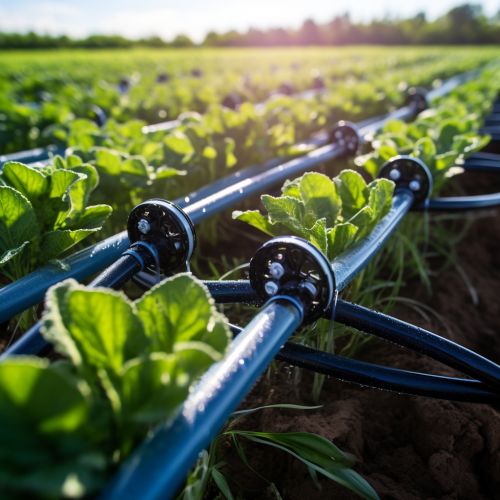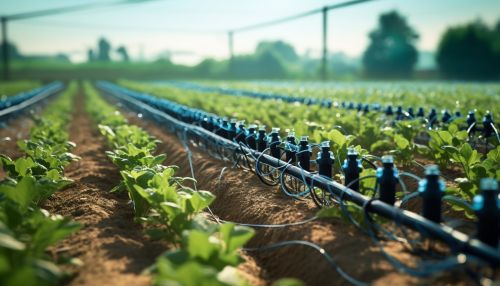Micro-irrigation
Introduction
Micro-irrigation, also known as localized irrigation, low volume irrigation, or trickle irrigation, is an irrigation method that minimizes the use of water and fertilizer by allowing water to drip slowly to the roots of plants, either onto the soil surface or directly onto the root zone, through a network of valves, pipes, tubing, and emitters. It is done through narrow tubes that deliver water directly to the base of the plant.


History
The development of micro-irrigation systems can be traced back to ancient times. The concept of localized irrigation is not new, with early forms of drip irrigation used in several ancient civilizations, including those in China, Persia, and the Middle East. However, modern micro-irrigation systems were developed and commercialized in the 1960s in Israel, where water resources were scarce and the need for efficient irrigation systems was high.
Types of Micro-Irrigation Systems
Micro-irrigation systems can be classified into four main types: drip irrigation, micro-spray or micro-sprinkler irrigation, bubbler irrigation, and subsurface drip irrigation.
Drip Irrigation
Drip irrigation is the most common type of micro-irrigation system. It involves the use of a network of pipes, tubing, and emitters to deliver water directly to the root zone of plants. The water is applied at a slow rate, allowing it to be absorbed by the soil before it can evaporate or run off. This method is particularly suited to areas with water scarcity or sandy soils, where traditional irrigation methods can lead to water wastage.
Micro-Spray or Micro-Sprinkler Irrigation
Micro-spray irrigation, also known as micro-sprinkler irrigation, is a system that uses small spray heads to distribute water over a small area. These systems are typically used in orchards, vineyards, and landscapes where a larger area needs to be irrigated. The spray heads can be adjusted to control the amount of water applied, making this system versatile and adaptable to different irrigation needs.
Bubbler Irrigation
Bubbler irrigation is a type of micro-irrigation system that delivers water to the root zone of plants through small devices known as bubblers. These devices emit water in a bubbling action, which then spreads out over the soil surface. This method is often used for irrigating trees and shrubs, as it can deliver a large volume of water in a short period.
Subsurface Drip Irrigation
Subsurface drip irrigation (SDI) is a type of micro-irrigation system where the water is delivered directly to the root zone of plants through a network of buried tubes or drip lines. This method is particularly effective in areas with high evaporation rates, as it reduces water loss due to evaporation by delivering the water directly to the roots.
Benefits of Micro-Irrigation
Micro-irrigation systems offer several benefits over traditional irrigation methods. These include:
- Water Conservation: Micro-irrigation systems apply water directly to the root zone of plants, reducing evaporation and runoff. This can result in significant water savings, making these systems ideal for areas with water scarcity.
- Fertilizer Efficiency: By applying water directly to the root zone, micro-irrigation systems also allow for more efficient use of fertilizers. Nutrients can be applied through the irrigation system (a process known as fertigation), reducing nutrient loss and improving plant health.
- Improved Crop Yield: Studies have shown that micro-irrigation can lead to improved crop yield and quality. By providing a consistent and optimal water supply, these systems can enhance plant growth and productivity.
- Reduced Labor Costs: Micro-irrigation systems are typically automated, reducing the need for manual watering and thus lowering labor costs.
- Environmental Benefits: By reducing water and fertilizer usage, micro-irrigation systems can also have positive environmental impacts. They can help to conserve water resources, reduce nutrient runoff into water bodies, and lower energy use (as less water needs to be pumped).
Limitations and Challenges
While micro-irrigation systems offer numerous benefits, they also have some limitations and challenges. These include:
- Initial Cost: The initial cost of installing a micro-irrigation system can be high, particularly for larger agricultural operations. However, these costs can often be offset by the water and labor savings over time.
- Maintenance: Micro-irrigation systems require regular maintenance to ensure they are operating effectively. This can include cleaning filters, checking and replacing emitters, and monitoring for leaks.
- Water Quality: The small emitters used in micro-irrigation systems can be prone to clogging, particularly if the water source contains sediment or other particulates. Therefore, water used in these systems typically needs to be filtered to prevent clogging.
- Uneven Water Distribution: If not properly designed and managed, micro-irrigation systems can lead to uneven water distribution, with some areas receiving too much water and others not enough. This can potentially impact plant health and yield.
Future Trends
The use of micro-irrigation systems is expected to increase in the future, driven by the growing need for efficient water use in agriculture due to increasing water scarcity and climate change. Advances in technology, such as the development of smart irrigation systems that use sensors and data analytics to optimize water use, are also likely to support the adoption of micro-irrigation.
